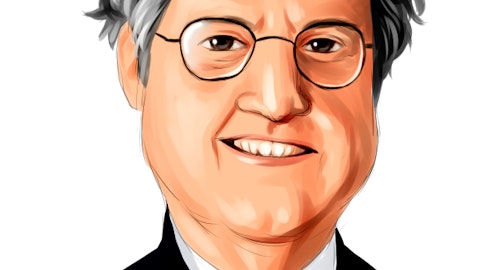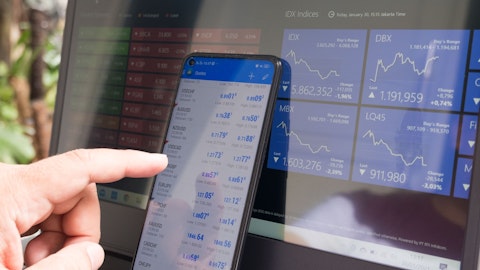Western Alliance Bancorporation (NYSE:WAL) Q4 2023 Earnings Call Transcript January 26, 2024
Western Alliance Bancorporation isn’t one of the 30 most popular stocks among hedge funds at the end of the third quarter (see the details here).
Operator: Good day, everyone. Welcome to Western Alliance Bancorporation’s Fourth Quarter 2023 Earnings Call. You may also view the presentation today via webcast through the Company’s website at www.westernalliancebancorporation.com. I would now like to turn the call over to Miles Pondelik, Director of Investor Relations and Corporate Development. Please go ahead.
Miles Pondelik: Thank you, and welcome to Western Alliance Bank’s fourth quarter 2023 conference call. Our speakers today are Ken Vecchione, President and Chief Executive Officer; Dale Gibbons, Chief Financial Officer; and Tim Bruckner, Chief Banking Officer will join for Q&A. Before I hand the call over to Ken, please note that today’s presentation contains forward-looking statements which are subject to risks, uncertainties, and assumptions. Except as required by law, the Company does not undertake any obligation to update any forward-looking statements. For more complete discussion of the risks and uncertainties that cause the actual results to differ materially from any forward-looking statements, please refer to the Company’s SEC filings, including the Form 8-K filed yesterday, which are available on the Company’s website. Now, for opening remarks, I’d like to turn the call over to Ken Vecchione.
Ken Vecchione: Thank you, Miles, and good morning, everyone. I’ll make some brief comments about our fourth quarter and full year 2023 earnings before turning the call over to Dale, who will review our financial results in more detail. After I discuss our 2024 outlook, Tim Bruckner will join us as usual for Q&A. Western Alliance’s diversified national commercial business strategy continued to drive strong momentum in the fourth quarter, as we generated earnings per share of $1.33 or $1.91 excluding $0.58 of one-time notable items. The quarter featured both healthy balance sheet growth, and additional balance sheet repositioning actions to further optimize our funding base. Looking past these notable items which Dale will explain shortly, highlights for the quarter included solid loan and deposit growth, ongoing capital and liquidity accumulation, and continued stable asset quality.
Deposit growth of $1 billion allowed us to continue to selectively reduce debt and borrowings. In Q4, we fully repaid $1.3 billion of advances from the Bank Term Funding Program, as well as a $300 million 6.5% AmeriHome Senior Notes, which were not replaced with new borrowings. Regarding the AmeriHome Notes, we seized an opportunity to repay this higher-cost debt at a discount. Additionally, our portion of the industry-wide FDIC special assessment to replenish the Deposit Insurance Fund totaled $66.3 million. Loans rose $850 million in the quarter, bolstered by C&I growth within our regional footprint. Western Alliance begins 2024 supported by a strong capital base and liquidity position. CET1 expanded approximately 150 basis points during the year to 10.8%, which equates to 9.8% when including AOCI.
80% of our deposits are either insured or collateralized, which ranks among the highest levels of the 50 largest U.S. banks. Despite the industry’s challenges, our total deposits increased 3% year-over-year. Asset quality also remains in very good shape. We’ve limited net charge-offs of only 6 basis points of average loans in 2023. Limited realized losses amidst a normalized credit backdrop is indicative, in our view, of the merits of lending with low advance rates adhering to conservative underwriting standards, and approaching credit mitigation proactively. Continuing to shift our funding base from borrowings to core deposits, better positions us to grow loans in a rate environment in flux likely to decline later this year. We have made investments and leadership additions in order to drive increased C&I growth in our regional footprint, expand fee income opportunities across client relationships, and complement the growth of our national business lines, particularly our leading national — our leading deposit focus verticals.
Overall in 2024, we look forward to consistent balance sheet and PPNR growth, with higher liquidity and improving capital. This will empower Western Alliance to continue partnering with our clients on their most important projects. Dale will now take you through the financial performance. Afterwards, I will provide you with our 2024 outlook.
Dale Gibbons: Well, thank you, Ken. For the year, Western Alliance produced net revenue of $2.6 billion, net income of $722 million, and EPS of $6.54. Net revenue increased 3% from the prior year, demonstrating the durability and flexibility of our business model. Net interest income rose $123 million or approximately 6% to over $2.3 billion, notwithstanding our curtailed loan growth and the completion of a series of asset sales earlier in the year. Non-interest income declined $44 million to $281 million for repositioning actions, the impact of fair value marks, as well as the slower mortgage purchase market. Non-interest expense of $1.6 billion, increased $466 million year-over-year, primarily due to higher earnings credit rates and deposit costs driven by the rising rate environment.
Moving on to fourth quarter trends and business drivers, we generated reported pre-provision net revenue of $220 million, net income of $148 million, and EPS of $1.33. As part of the balance sheet optimization efforts conducted earlier to support and improve our earnings trajectory, we repaid $300 million of AmeriHome Senior Notes at a discount. We utilized this gain to better position the balance sheet by selling securities, as well as MSR fair-value adjustments in sales, which combined to produce a pre-tax loss of $4.5 million, in addition to the $66 million FDIC special assessment. When excluding these one-time notable items, we generated adjusted net income of $211 million and EPS of $1.91. Net interest income increased $4.7 million during the quarter to $592 million, from higher average earning asset balances and reduced higher-cost borrowings.
GAAP non-interest income was $91 million, or excluding notable items a $126 million, which was down approximately $3 million from Q3. During the quarter, loans sold approximately $200 million of Mortgage Servicing Rights, which improved our capital ratios despite incurring a loss of $11 million on disposition. As prepayment speeds began to recover from historically low levels, the valuation of Mortgage Servicing Rights moved lower at an accelerated pace, which resulted in a $14 million fair-value adjustment net of hedging. We don’t believe this aggregate $25 million charge is indicative of the earnings profile of our Mortgage Banking business. Lock volumes rebounded 29% year-over-year and may be indicative of continued momentum into 2024. Since the December rate rally and resulting lower mortgage rates, we have experienced incremental refinance volume and firming margins.
Should mortgage rates trend lower in future quarters, we would expect this business to benefit which has not been captured in our go-forward guidance. Additionally, income from equity investments was elevated by approximately $8 million due to outsized gains from solar tax credit investments with higher-than-expected performance during the quarter. GAAP non-interest expense was $462 million, or excluding noted items, $435 million, a quarterly increase of $9 million. Deposit cost growth slowed markedly, increasing $3 million in Q4 as our Settlement Services and Homeowners Association businesses experienced strong growth in new customers that have surpassed seasonal declines in Mortgage Warehouse. Provision expense was $9.3 million, reflecting steady asset quality.
Lastly, our effective tax rate of approximately 30% was temporarily elevated in Q4 primarily because of timing issues related to the low-income housing units that were not placed into service in 2023. The 2024 tax rate should reset at 22% to 23%. Loans Held For Investment grew $850 million to $50.3 billion, while deposits increased $1 billion to $55.3 billion at quarter-end. Mortgage Servicing Rights declined to $1.1 billion from MSR sales and reduced valuations resulting from the lower rate environment. Overall, we continue to build high-quality liquid asset levels and on-balance sheet liquidity via strong deposit growth. Debt repayments previously discussed, reduced investments in cash by $351 million from September 30th. Strong deposit growth over the last three quarters has allowed us to cut total borrowings and debt by half from the end of Q1.

Finally, tangible book value per share increased $3.06 or 7% over the prior quarter, and 16% year-over-year to $46.72 from retained earnings and reduced drag from negative all other comprehensive income. Loans Held For Investment growth was predominantly from C&I categories, some of which we’re moving at higher-end line utilization. Construction and land loans were up $220 million with a little under half of this contribution from lot banking. Given the national undersupply of homes and a greater likelihood of near-term rate cuts, we are still positive about the macroeconomics for this business. Deposit growth of $1 billion was achieved despite typical seasonal declines in Mortgage Warehouse deposits related to tax and insurance payments. We continue to experience broad-based growth from our specialized value-added deposit channels.
HOA had its best Q4 ever and we believe it will retain and possibly extend its leading market share in the country as achieved in Q3 of last year. Settlement Services, Tech and Innovation, Corporate Trust, and our Digital Consumer Channel, all grew materially and contributed to well-diversified growth. Non-interest-bearing DDA comprised 26% of total deposits, of which 45% have no cash payment of earnings credits. The decline in non-interest-bearing balances was primarily driven by the expected $3 billion decrease from typical Mortgage Warehouse seasonality of property tax and insurance escrow funds. There has been no client attrition associated with these outflows and this decline is recovering as anticipated this quarter. Moving on to net interest drivers, HFI loan yield decreased 8 basis points due to the full quarter impact of the $1.3 billion reclassification of loans from Held For Sale to Held For Investment at the end of Q3.
This coincided with — coincidently resulted in Held For Sale yields climbing 31 basis points. Going forward, we anticipate HFI yields to continue to be supported by an average of $2.9 billion of loans repricing or maturing third quarter in 2024. The yields on total investments expanded 8 basis points in Q4 to 4.99%. The Securities portfolio grew $1.9 billion to $13 billion from the ongoing HQLA goal, which has increased treasury from $900 million at the end of Q1 last year to approximately $4.9 billion at year-end. The cost of interest-bearing deposits increased 7 basis points, markedly slower than the prior quarter, and the total cost of funds increased 2 basis points to 2.82% due to an increase in demand deposits and lower short-term borrowings.
Deposit growth enabled the $768 million increase, a reduction in average short-term borrowings, as well as 6 basis points of improvement in the cost of interest-bearing liabilities. In aggregate, net interest income increased approximately $5 million, while the net interest margin of 3.65% came in at the mid-point of our Q4 guidance. Our net interest income growth was exceeded by the growth rate of average earning assets. Non-interest expenses were impacted by $27 million at net notable items this quarter. Adjusting for these one-time items, as well as deposit costs, our adjusted efficiency ratio rose 100 basis points to 51%. We expect deposit costs will experience relief from a cessation of rate hikes and should fall as rates decline. For historical context, average ECR balances were $19.9 billion in the fourth quarter compared to $17 billion in Q3 and $15.4 billion in Q4 of ’22.
We expect ECR-related deposits to remain a consistent relative proportion of our deposit base as total deposits grow. Based upon our rate forecast and generally a high beta repricing for ECR-related deposits, we expect such pricing to largely decline and lockstep with the rate cuts, offsetting any potential net interest margin declines. Asset quality metrics continue to remain stable and in line with what we reported last quarter. The aggregate net increase in Special Mention loans and classified assets was only $7 million from the Q3 level. Non-performing assets increased to $281 million, equating to 40 basis points of total assets, which is 5 basis points above the third quarter. Quarterly net loan charge-offs were $8.5 million, or 7 basis points of average loans, which was aligned with Q3 net charge-offs.
Provision expense of $9.3 million was a function of loan growth and has slightly improved Moody’s consensus forecast. Though our consensus and some early risk ratings for our ACL still incorporated 80% recessionary outlook. Our allowance increased $10 million from the prior quarter to $337 million and the ACL ratio with 73 basis points covered a 135% of non-performing loans. Looking at the reserve block, you’ll see an updated look on the context behind our allowance, which when considering insured loans and those in no-loss categories, the allowance shifts up to 1.31% of loans. Our CET1 ratio rose 20 basis points to 10.8% or 9.8% when adjusted for the AOCI debit. Our tangible common equity to total assets grew approximately 50 basis points from Q3 to 7.3%, from earnings and the improved AOCI position.
Tangible book value per share increased $3.06 from Q3 to $46.72 from earnings and recapture of AOCI marks. The $220 million improvement in AOCI resulted from substantial decreases in intermediate-term treasury rates during the quarter. Our consistent upward trajectory in tangible book value per share has outpaced peers by almost 5 times from 2013, including strong growth in 2023. Over most time periods, Western Alliance continues to generate a top-quartile total shareholder return relative to both asset-light peers and the Regional Banking index. Turning the call back to Ken.
Ken Vecchione: Thanks, Dale. Our guidance for 2024 is to build on the second-half momentum of 2023 and progress towards returning to above-industry returns. In the first half of 2024, the Company will emphasize liquidity growth over loan growth, drive capital above 11%, and further build our HQLA portfolio, which will temper earnings growth for the first half of the year. As these goals are achieved, earnings momentum will accelerate in the second half of 2024 and into 2025. So, for the full year of 2024, we expect continued thoughtful balance sheet growth driven by our diversified business model, with an origination mix designed to drive net interest income above 2023 levels. Loan and core deposits are expected to grow $2 billion and $8 billion respectively for the year.
Core deposits-driven growth should continue to push our loan-to-deposit ratio towards the mid-80% level by the middle of this year. Regarding capital, we are targeting a CET1 ratio above 11%, reflecting steady organic capital accumulation in concert with balance sheet growth. Net interest income should grow 5% to 10% from a Q4 2023 annualized jumping-off point. This forecast assumes four 25 basis point cuts back-loaded in the year. We expect any future NIM compression resulting from the rate cuts to be matched by comparable deposit cost declines in non-interest expense, which will be accretive to earnings. Non-interest income should increase 10% to 20% from an adjusted 2023 baseline level of $397 million, which excludes 2023’s mark-to-market adjustments and the impact of asset sales, as we prioritize growing commercial banking-related fee income from holistic customer relationships.
Mortgage banking-related income will be somewhat dependent on the rate environment and mortgage buying — I should say, and mortgage buying. But we’re encouraged that with the recent low rate environment, application volume is picking up with firmer margins thus far in early 2024. Non-interest expense, inclusive of the ECR-related deposit costs, should rise only 0% to 2% from an annualized adjusted Q4 baseline of $1.740 billion and allow for continued operating leverage. In aggregate, these factors will enable WAL to consistently grow PPNR throughout the year. Asset quality remains manageable and projects continue — and we project continued support from our sponsors. Based on our conservative underwriting and low advance rates, net charge-offs are expected to be 10 basis points to 15 basis points for the year as the economic cycle normalizes.
Lastly, we expect the effective tax rate to revert between 22% and 23% starting in Q1. At this time, Tim, Dale, and I are happy to take your questions.
See also 20 States Where You May Not Be Able to Retire at Age 65 and 30 Most Affordable Beach Towns to Live in the US.
Q&A Session
Follow Western Alliance Bancorporation (NYSE:WAL)
Follow Western Alliance Bancorporation (NYSE:WAL)
Operator: Thank you. [Operator Instructions] Our first question for today comes from Casey Haire of Jefferies. Your line is now open. Please go ahead.
Casey Haire: Yes. Thanks. Good morning, everyone. So, I wanted to start on the four cuts and how that impacts the PPNR guide. Obviously, it hits you guys a number of ways. Dale, I think you said that it does not — your fees does not account for any upside in mortgage banking. It sounds like the deposit costs within expenses are 100% beta. Can you just confirm that? And then, the four cuts, how would that — what kind of deposit beta are you expecting for the non-ECR component, and how that would impact NII?
Dale Gibbons: Yes. In aggregate, I mean to getting to PPNR, the net impact is fairly nominal. I mean, as we’ve indicated in the past, if you just look at net interest income, we’re modestly asset-sensitive. So, that would be a little bit of a decrement. But of course, you alluded to the ECR price deposits, which we expect to fall and fall in line. Yes, so put those together, we think we’re getting now modestly liability-sensitive and we have a net benefit then in PPNR, excluding the AmeriHome piece which is the option on — this is a call option if things get much better and that’s good space.
Casey Haire: So, AmeriHome would be gravy if it did, but obviously, if it’s back-half-loaded, it might be modest.
Dale Gibbons: Yes. So, the mix will look a little different. I mean, if you had a more accelerated rate decline, maybe you’re going to see a faster decline perhaps in net interest income, reflecting the net interest income profile that we have. But again, when you layer-in the deposit costs, I think it’s going to eliminate that.
Casey Haire: Okay. And then, so the loan-to-deposit growth guide for ’24, you’ve got $613 million of liquidity to play with. What is the plan for that? Build the bond book? Build cash? Pay down borrowings? Just wondering what your plans are there.
Dale Gibbons: Yes. So, when I think about the year, I think about it — the first half of the year, we’re building the liquidity profile as you mentioned. With that, we’re really going to build our HQLA portfolio. And we’re looking to drive our loan-to-deposit ratio as I just said, in the mid-80%s. From there, it’s growth towards a much bigger and better 2025. So, we need to continue to reposition ourselves. We think we’ll have that done by the end of the second quarter. And then, it will be a little bit more traditional earnings as you see them — as you have seen them historically from us. But, I would say — and when you think about it, the deposit and loans are more coming in across the year in a ratable fashion, about $500 million per quarter for loans and approximately $2 billion per quarter for deposits.
Casey Haire: Got you. Thank you. And then just last one. Dale, you mentioned the DDA. It sounds like it’s recovering seasonally within Mortgage Warehouse, just any update you can share on how much of that $3 billion has come back in?
Dale Gibbons: Well, so, it’s really based upon the semi-annual property tax payments, largely in California. And so, we would expect that we’re going to get half of that or two-thirds of that this quarter. And then the rest of it would start coming in. The payments due in May are less dramatic in terms of kind of the dip that we see. Meanwhile, other Warehouse funds look to be growing consistently, and we’re also off to a good start in our HOA business for Q1.
Ken Vecchione: Casey, let me just add, right now we’re on track to beat the $2 billion for our Q1. And that’s inclusive of the HOA deposits coming back in.
Casey Haire: Great. Thanks, guys.
Dale Gibbons: Thanks.
Operator: Thank you. Our next question comes from Steven Alexopoulos from J.P. Morgan. Your line is now open. Please go ahead.
Steven Alexopoulos: Hi, everybody. I wanted to start on the margin. So, you were 3.65% in the quarter, right in the middle of what you had guided to. Dale, for you, how should we think about the NIM trending the backdrop of four cuts? And then it’s funny, when I look at where the NIM was when we had a more normal curve, I mean, you guys were like 4.50%, but this is a completely different balance sheet today. So, assuming we eventually get a normal curve, normal level rates, like what’s a reasonable NIM for this balance sheet?
Ken Vecchione: So, hello, Steve, it’s Ken. What I would say is, again, thinking about the year, the first two quarters of the year, NIM should track consistent with our Q4 NIM of 3.65%. And then Q3 and Q4, the NIM will gently roll down as the price — as the rate cuts come into play. But offsetting that NIM decline will be the reduction in ECR expenses.
Dale Gibbons: So, what’s transpired is, we have and we expect to continue to have considerably more liquidity on the balance sheet, and that is going to kind of depress NIM at basically a permanent basis. Where can we be kind of going forward, I think we can be close to kind of where we are. So, maybe the 3.5% range is kind of sustainable kind of over kind of a broader economic cycle than what we have seen. We’ll probably have a little bit better return on the Residential portfolio that we presently have. But for the most part, I think our numbers rather than being in the 4%s, I think we’re destined for the 3%-level here going forward.
Steven Alexopoulos: Got it.
Dale Gibbons: Preamble.
Steven Alexopoulos: Okay. And then on the expense guide, so you guys were $437 million on the ECR deposit cost in ’23, what’s assumed within this expense guidance for 2024 for the cost of ECR deposits, like where is that roughly?




